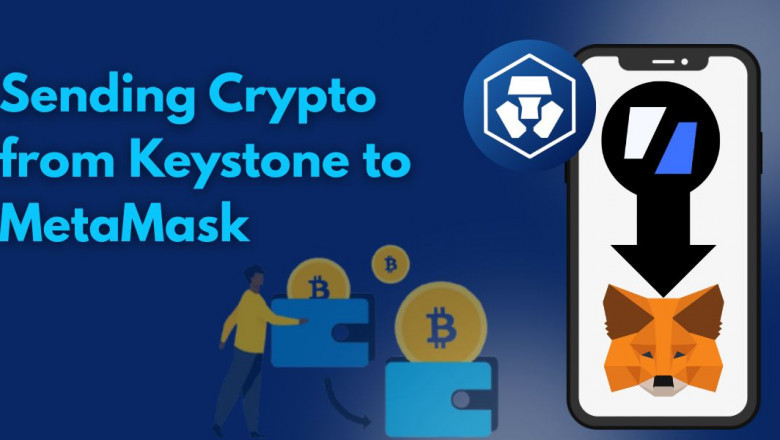views
Sending Crypto from Keystone to MetaMask
Transferring cryptocurrency securely between wallets is a critical task in crypto management. If you use the Keystone hardware wallet for storing your assets offline and MetaMask for interacting with decentralized applications, knowing how to move funds between the two platforms is essential. In this article, we’ll walk you through a detailed guide on sending crypto from Keystone to MetaMask, along with tips to avoid errors and keep your assets safe.
Why Transfer from Keystone to MetaMask?
Keystone is known for its air-gapped, offline security, meaning it keeps your private keys completely isolated from the internet. This makes it a great long-term storage solution for crypto holdings.
MetaMask, on the other hand, is a hot wallet that gives you real-time access to DeFi platforms, token swaps, and dApps. By using both together, you can enjoy high-level security without sacrificing flexibility.
The main advantage of using these wallets together is that you can keep your assets safe in Keystone while executing transactions through MetaMask.
Step 1: Prepare Keystone and MetaMask
Before you start the transfer process, ensure the following:
-
Your Keystone wallet is fully set up, updated, and backed up securely.
-
You have installed the MetaMask extension in your browser or on your mobile device.
-
Both wallets are using the same network (e.g., Ethereum Mainnet).
Once ready, open MetaMask and click on the option to connect a hardware wallet. Choose QR-based signing, which is how Keystone securely communicates.
Step 2: Connect Keystone with MetaMask
To connect the wallets:
-
On your Keystone, go to the crypto account you want to export.
-
Select the “Export Public Key” or “Connect to MetaMask” option.
-
A QR code will appear on the Keystone screen.
-
In MetaMask, scan the QR code to link the Keystone address.
This allows MetaMask to view your Keystone address and balance, but it cannot access private keys or initiate unauthorized transactions.
Step 3: Initiate a Transfer in MetaMask
Now that MetaMask can access your Keystone account:
-
In MetaMask, select the Keystone-linked address.
-
Click “Send” and enter the recipient wallet address.
-
Specify the crypto amount and check the gas fee.
-
Confirm the details and generate a QR code of the unsigned transaction.
This transaction is now ready to be signed securely using your Keystone device.
Step 4: Sign Transaction on Keystone
With the unsigned transaction ready, do the following:
-
Open your Keystone wallet.
-
Scan the QR code shown by MetaMask.
-
Review the transaction details carefully.
-
Approve and sign the transaction on Keystone.
-
A signed QR code will be displayed on Keystone.
Go back to MetaMask and scan this signed transaction QR code. Once scanned, MetaMask will broadcast the transaction to the blockchain.
This process is designed to send crypto from Keystone to MetaMask wallet without exposing private keys to the internet.
Step 5: Verify the Transaction
After broadcasting, you can:
-
Monitor the transaction status on MetaMask.
-
Use a blockchain explorer (e.g., Etherscan) to confirm the transfer.
-
Check that the correct token and amount have arrived at the destination address.
If everything looks good, your transfer is complete!
Common Mistakes and How to Avoid Them
While the process is secure, a few errors can slow it down or cause confusion. Here are the most common crypto withdrawal errors and how to avoid them:
-
Wrong Network Selected: Always ensure both wallets are using the same blockchain network.
-
Low Gas Fee: Setting an insufficient gas fee may delay or fail the transaction.
-
QR Code Not Scanning: Clean your camera lens, adjust lighting, and ensure the screen is clear.
-
Firmware Not Updated: Ensure both MetaMask and Keystone firmware/software are current.
Avoiding these simple mistakes can help ensure smooth transactions and secure transfers.
Security Tips for Transfers
-
Never export private keys from your Keystone to MetaMask or any other online platform.
-
Use strong passwords and enable two-factor authentication (2FA) where possible.
-
Store your recovery phrase in a safe, offline location.
By keeping your private keys offline and signing transactions via QR code, you minimize exposure to hacks and phishing attempts.
Conclusion
Using Keystone and MetaMask together is one of the safest ways to manage and transfer your crypto assets. The QR-based signing process ensures that your keys never touch the internet while still giving you full functionality through MetaMask.
Whether you're interacting with DeFi apps or just sending funds to another wallet, understanding how to use these tools properly helps you stay secure and in control.
Ready to make your first transaction? Follow the steps above, and enjoy the best of both worlds: hardware security and DeFi convenience.














Comments
0 comment